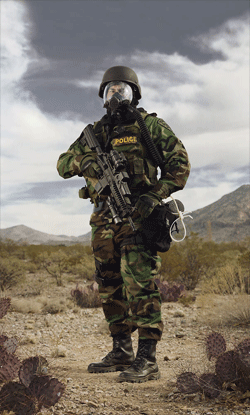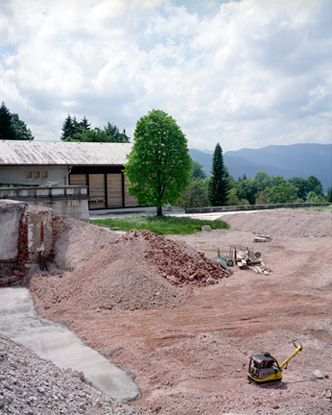Loaded landscapes

About the Exhibition
Work by:
Ayreen Anastas
Alan Cohen
John Duncan
Isabelle Hayeur
Atta Kim
Shai Kremer
New Catalogue (Luke Batten & Jonathan Sadler)
Simon Norfolk
Paul Shambroom
Anna Shteynshleyer
Joel Sternfeld
Loaded Landscapes offers a peculiar type of landscape photography, one concerned with place, but place laden with human experience. The twelve contemporary artists in this exhibition seek politically charged sites with significant histories, yet their images offer little or no discernible evidence of either past events or current tension. Often invoking the conventions of romantic landscape painting and photography, these artists directly raise the question of photography’s real ability to document a place and expose its history. A picture of a field can be simply a picture of a field; its significance can only be materialized by human experience [1].
Often invoking the conventions of romantic landscape painting and photography, these artists directly raise the question of photography’s real ability to document a place and expose its history.
Romantic European and American landscape painters were concerned with representing the sublime in nature, an abstract notion perhaps most famously articulated by 18th-century political theorist Edmund Burke, who believed that a life of feeling and spirit depended on recognizing harmony within the larger order of the universe [2]. A state of mind conjured by natural beauty, the sublime transcends time and place. Romantic pictures were designed to produce a mixture of awe, respect, and moral enlightenment, and to emphasize the power of God as reflected in his greatest creation, the natural world. The paintings are dramatically vast in scope, sometimes include a person dwarfed by the grand space, and are rich in tonalities and colors. (Works by Hudson River School painter Asher Durand, and German romantic Casper David Friedrich are good examples.) While formally similar to romantic works, the photographic landscapes in this exhibition are distinguished by time and place once we know the location and often-invisible historical context.
Sublime or not, a place is defined by the human experience and knowledge brought to it. We know a place because we live there, visit, read about it. Without this sort of knowledge, we simply consider a picture of a place formally intriguing or picturesque. Photographs by Anna Shteynshleyger and New Catalogue attest to this critical difference between the simple image and the loaded landscape. Shteynshleyger (Russian, b. 1977) photographs the vast valleys and mountains in contemporary Kolyma and Perm, Siberia. For Russians Kolyma is associated with death, but her pictures show no direct evidence of the 1.7 million prisoners and workers who died there working in gulags during the course of Stalin’s regime. Rather, they are stunning photographs reminiscent of the 19th-century Russian painter Isaak Levitan. Using a similar strategy, New Catalogue (Luke Batten, American, b. 1968 and Jonathan Sadler, American, b. 1965) document both the grandeur of the Obersalzberg Mountain Range in Southern Germany, famous as Adolf Hitler’s favorite vacation area, and the construction of a new five-star hotel just 300 yards from the ruins of Hitler’s mountain retreat. Whereas Dachau, Buchenwald, and Sachsenhausen, with their preserved structures, elicit a moral imperative to remember, mourn, warn, and educate about the Holocaust, the Bavarian government is attempting to erase Hitler’s legacy from their picturesque landscape [3].
Alan Cohen (American, b. 1943) avoids the romantic landscape conventions almost completely. His pictures are devoid of color and have no horizon line. He pointed his camera directly down at the mass graves in Cambodia where an estimated 1.5 million people were executed and buried by the ruling party, the Khmer Rouge. Although nature is concealing the graves, the unnaturally rectangular depressions in the earth insistently reveal a prior human history.
While Joel Sternfeld (American, b. 1944) and Isabelle Hayeur (Canadian, b. 1969) emphasize large vistas and dramatic skies in their work, they also refer to our more media-savvy culture. They focus on sites that are eerily familiar. Working more like a photo-journalist than a landscapist, Sternfeld returns to politically charged sites in America—the parking lot at Taylor Hall at Kent State University or the corner of Florence and Normandie Avenues in Los Angeles where Rodney King was beaten. Hayeur’s panoramic landscapes also look familiar, but are harder to pin down than Sternfeld’s pictures. The context of this exhibition leads us to bring our collective knowledge and experiences to Hayeur’s pictures, hoping to identify whatever significant event must have occurred there. The disrupted earth leaves a clue that humanity has tampered with this place. But Hayeur’s places are, in fact, fictitious. She creates digital montages from different places and times to create an altogether new reality that has no possibility of revealing any truths other than the camera’s ability to convince us that seeing must be believing. But in this case there is nothing to believe.
The context of this exhibition leads us to bring our collective knowledge and experiences…hoping to identify whatever significant event must have occurred there.
In the work so far discussed, actual or imagined crimes are now obscured by the passage of time. They live in cultural memory and contemporary awareness, but they are empty of crucial evidence. The second part of this exhibition contains a video and photographs of places currently divided by religion, cultural history, or current political strife, and are focused on real and convincing evidence. Palestinian artist Ayreen Anastas has created a contemporary video map of Bethlehem inspired by a map of the city from 1973. The video explores nationalism and belonging in Palestine, including life under occupation and geopolitical displacement. It is concerned with what is absent from the older map, as well as what is represented there relative to the actual site today—streets after curfew, olive trees bearing signs that warn of the imminent confiscation of land. Shai Kremer (Israeli, b. 1974) references violence within the ever-changing Israeli landscape and the complexities of building a wall along the divide between Israel and the Palestinian Territories. Similarly, John Duncan (Northern Irish, b. 1968) captures the now slightly eased tension between Catholic and Protestant Northern Ireland, where Belfast continues to divide, and define, its neighborhoods with layer upon layer of fences and walls. Both in the West Bank and in Belfast these walls are ostensibly an attempt to prevent terrorism and violence but ultimately only serve to damage the psyches of subsequent generations. They recall the impermanent efficacy of the Great Wall of China and the Berlin Wall.
In the United States, where wide-open landscapes symbolize freedom, Paul Shambroom (American, b. 1956) blocks the mythic view with full-body portraits of men wearing heavy protective gear and holding machinery or weapons. They seem to be denying access to the landscape behind them. These men are in fact trainees for the United States Department of Homeland Security, preparing for future terror attacks and illegal border crossings. The tension on the border between the United States and Mexico is examined in Simon Norfolk’s (British, b. 1963) sobering night pictures of the border towns in Arizona and Mexico and reveal the 15-foot fence that mainly serves to force illegal border crossing into severe, often lethal desert areas.
Atta Kim (South Korean, b. 1955) leaves his camera shutter open for four to eight hours focused on the most heavily armed border in the world, the Demilitarized Zone dividing North and South Korea. North Korean soldiers physically stand nose to nose with South Korean and American soldiers on the border and have done so since the country was divided before the Korean War more than 50 years ago. Kim’s method turns the vast 155-mile-long, 2.5-mile-wide no-man’s land that divides the two countries into a hazy landscape. There is no trace of human presence or conflict except for an occasional glimpse of a fence. But the title of the project, ON-AIR Project, DMZ Series, The Central Front, reminds us of global tension that is far from the sublime.
Romantic notions of the sublime are qualified, or brought into tension with the recollection of a variously brutal human history.
While formally reminiscent of earlier classical landscape photography and painting—eliciting notions of the sublime and of human awe in the face of nature—each of the artists in this exhibition approach his or her subject with an altogether different set of interests by asserting human history in the landscape through either conceptual awareness or peripheral physical evidence. Romantic notions of the sublime are qualified, or brought into tension with the recollection of a variously brutal human history. These landscapes remind us simultaneously of our humanity and inhumanity.
—Natasha Egan, Associate Director
1 Tim Cresswell, Place: A Short Introduction (Oxford: Blackwell Publishing, 2004), p. 12.
2 Edmund Burke, A Philosophical Enquiry into the Origin of Our Ideas of the Sublime and Beautiful, London, 1757, in Edmund Burke: A Philosophical Enquiry into the Origin of Our Ideas of the Sublime and Beautiful and other Pre-Revolutionary Writings(London: Penguin Classics, 1999), p. 49.
3 Timothy W. Ryback, “The Hitler Shrine,” (Atlantic Monthly, April 2005), p. 131.
Image Gallery

